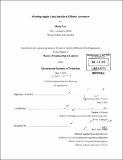| dc.contributor.advisor | Stephen C. Graves. | en_US |
| dc.contributor.author | Lew, Marta | en_US |
| dc.contributor.other | Massachusetts Institute of Technology. Engineering Systems Division. | en_US |
| dc.date.accessioned | 2011-02-23T14:25:18Z | |
| dc.date.available | 2011-02-23T14:25:18Z | |
| dc.date.copyright | 2010 | en_US |
| dc.date.issued | 2010 | en_US |
| dc.identifier.uri | http://hdl.handle.net/1721.1/61180 | |
| dc.description | Thesis (M. Eng. in Logistics)--Massachusetts Institute of Technology, Engineering Systems Division, 2010. | en_US |
| dc.description | Cataloged from PDF version of thesis. | en_US |
| dc.description | Includes bibliographical references (p. 92-97). | en_US |
| dc.description.abstract | The recent developments in retail industry created a challenging environment for companies in the sector and their trade partners. Retailers' focus on recovering their financial results through eliminating unproductive inventory and reducing unnecessary complexity has led to an increased pressure on their suppliers. In order to adapt to the new market settings, a major manufacturer of consumer goods wanted to be able to look at its product portfolio through the perspective of its direct clients. This capability was established in form of a decision model which utilizes Point of Sales, operational, and financial data of the company's downstream partners to recommend assortment changes at item, category and cross-category levels, as well as to project results of these changes. The tool uses the input data and information on product variety to assess risk of lost sales and to quantify possible improvements in product availability, retailers' logistics costs, efficiency of their operations, utilization of supply chain assets, and-perhaps most importantly-their revenues and profits. The new decision model reinforced the manufacturer's competence to support objectives of clients while continuing to pursue its own goal of offering end-customers products which they need, trust and value. | en_US |
| dc.description.statementofresponsibility | by Marta Lew. | en_US |
| dc.format.extent | 97 p. | en_US |
| dc.language.iso | eng | en_US |
| dc.publisher | Massachusetts Institute of Technology | en_US |
| dc.rights | M.I.T. theses are protected by
copyright. They may be viewed from this source for any purpose, but
reproduction or distribution in any format is prohibited without written
permission. See provided URL for inquiries about permission. | en_US |
| dc.rights.uri | http://dspace.mit.edu/handle/1721.1/7582 | en_US |
| dc.subject | Engineering Systems Division. | en_US |
| dc.title | Modeling supply chain benefits of efficient assortment | en_US |
| dc.type | Thesis | en_US |
| dc.description.degree | M.Eng.in Logistics | en_US |
| dc.contributor.department | Massachusetts Institute of Technology. Engineering Systems Division | |
| dc.identifier.oclc | 699809406 | en_US |
